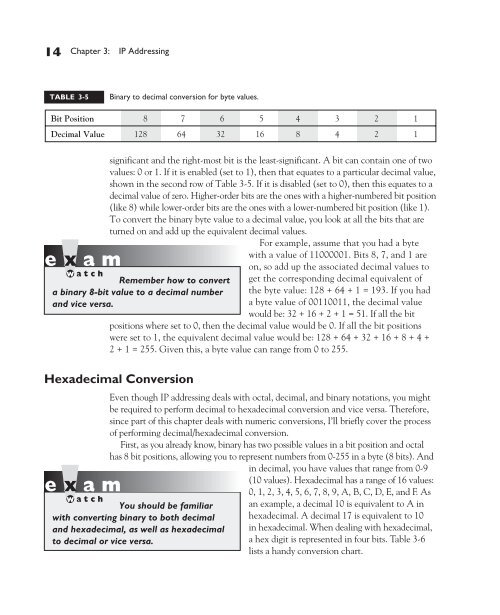ch03 IP Addressing.pdf - The Cisco Learning Network
ch03 IP Addressing.pdf - The Cisco Learning Network
ch03 IP Addressing.pdf - The Cisco Learning Network
Create successful ePaper yourself
Turn your PDF publications into a flip-book with our unique Google optimized e-Paper software.
14 Chapter 3: <strong>IP</strong> <strong>Addressing</strong><br />
TABLE 3-5 Binary to decimal conversion for byte values.<br />
Bit Position 8 7 6 5 4 3 2 1<br />
Decimal Value 128 64 32 16 8 4 2 1<br />
significant and the right-most bit is the least-significant. A bit can contain one of two<br />
values: 0 or 1. If it is enabled (set to 1), then that equates to a particular decimal value,<br />
shown in the second row of Table 3-5. If it is disabled (set to 0), then this equates to a<br />
decimal value of zero. Higher-order bits are the ones with a higher-numbered bit position<br />
(like 8) while lower-order bits are the ones with a lower-numbered bit position (like 1).<br />
To convert the binary byte value to a decimal value, you look at all the bits that are<br />
turned on and add up the equivalent decimal values.<br />
For example, assume that you had a byte<br />
with a value of 11000001. Bits 8, 7, and 1 are<br />
on, so add up the associated decimal values to<br />
Remember how to convert<br />
a binary 8-bit value to a decimal number<br />
and vice versa.<br />
get the corresponding decimal equivalent of<br />
the byte value: 128 + 64 +1=193. If you had<br />
a byte value of 00110011, the decimal value<br />
would be: 32 + 16+2+1=51.Ifallthebit<br />
positions where set to 0, then the decimal value would be 0. If all the bit positions<br />
were set to 1, the equivalent decimal value would be: 128 + 64 + 32 + 16 + 8 + 4 +<br />
2 + 1 = 255. Given this, a byte value can range from 0 to 255.<br />
Hexadecimal Conversion<br />
Even though <strong>IP</strong> addressing deals with octal, decimal, and binary notations, you might<br />
be required to perform decimal to hexadecimal conversion and vice versa. <strong>The</strong>refore,<br />
since part of this chapter deals with numeric conversions, I’ll briefly cover the process<br />
of performing decimal/hexadecimal conversion.<br />
First, as you already know, binary has two possible values in a bit position and octal<br />
has 8 bit positions, allowing you to represent numbers from 0-255 in a byte (8 bits). And<br />
in decimal, you have values that range from 0-9<br />
(10 values). Hexadecimal has a range of 16 values:<br />
0, 1, 2, 3, 4, 5, 6, 7, 8, 9, A, B, C, D, E, and F. As<br />
You should be familiar<br />
with converting binary to both decimal<br />
and hexadecimal, as well as hexadecimal<br />
to decimal or vice versa.<br />
an example, a decimal 10 is equivalent to A in<br />
hexadecimal. A decimal 17 is equivalent to 10<br />
in hexadecimal. When dealing with hexadecimal,<br />
a hex digit is represented in four bits. Table 3-6<br />
lists a handy conversion chart.

















